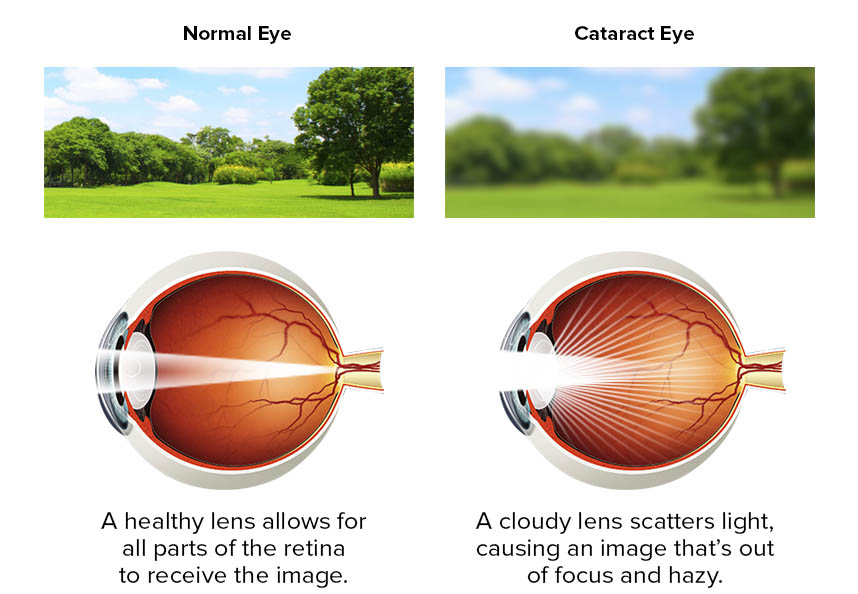Cataract
- Home
- Cataract
The Natural Lens is located directly behind the iris and pupil of the eye. It is transparent and it changes the focal distance of the eye by changing its shape. The Lens is the second part of the eye after the cornea.
Common disease of the natural lens is Cataract. The Cataract is the clouding of the eye’s natural lens. It is the most common cause of vision loss or blindness in people. A cataract usually develops slowly and in this condition, the objects look blurry, hazy or less colourful.
Cataract is common after age 50. Cataract develops slowly and eventually interferes with the vision. The cataract can develop in both the eyes but it usually less in one eye than another.
People suffering from cataract problem are unable to do their daily activities efficiently like reading, driving a car especially at night etc. Timely diagnosis and treatment is essential to get rid of cataract.

Different Types of Intraocular Lenses (IOL)
During cataract surgery, the natural clouded lens is replaced with an artificial lens known as an Intraocular Lens (IOL). Doctor places a clear lens inside the eye to sharpen light particles as they move through the eye. Most of the lenses are made up of silicone or acrylic materials while some are also coated with a material that protects eyes from the damage caused by sun rays.
Major types of Intraocular Lens (IOL) are
- Monofocal Lens- A Monofocal lens is the most common type of lens which is used in cataract surgery and it is designed to provide the clear vision at one particular distance. Most people who choose monofocals have their IOLs set for distance vision. Monofocal lenses allow people to do their routine work without/ with glasses. People who enjoy reading or knitting choose a monofocals that offers near vision.
- Multifocal IOL- Multifocal IOLs have multiple corrective zones built into the lens (much like bifocal or trifocal eyeglasses). This allows people to see both near and far objects. Some multifocals lenses also correct intermediate vision.
- Toric Lenses- A toric lens is designed to correct the specific refractive error that causes your astigmatism and it is also used for patients who have cylinder power.
Causes of Cataract
The common causes of cataract are:
- Age- The cataract most commonly is causes at an older age when the natural lens becomes cloudy.
- Congenital- Cataract conditions are present by birth
- Trauma- This is caused by accidents causing eye injury.
- Secondary Causes- Cataract is also caused by certain medications or other medical conditions like diabetes.
Symptoms of Cataract
Common symptoms of cataract are:

- Cloudy/blurry vision
- Glare intolerance
- Frequent change in eye glass number
- Double vision
- Difficulty seeing at night
Risk Factors of Cataracts
Common risk factors of cataracts are:
- Older age
- Diabetes
- Steroid overuse
- Previous eye injuries
- Early family history of cataract hi
- Sun light exposure for a longer time
- High exposure to radiation from X-rays and cancer treatments
Diagnosis of Cataract
Timely diagnosis is important to treat cataract. Doctor generally ask medical history, symptoms and will perform an eye examination. Doctor will also conduct several eye tests including:
Visual acuity test
Slit-lamp examination
Retinal exam & many other depending on individual
Treatment of Cataract
Cataract treatment depends on the stage of cataract. The permanent treatment is surgery. In a Cataract surgery, the natural lens of the eye is replaced with artificial lens which is called an intraocular lens. The cloudy natural lens is replaced to restore the vision of the patient and is performed on an outpatient basis which means it does not require an overnight stay in the hospital. The surgery can be Blade or Bladeless.
Procedures to treat Cataract include
- Phacoemulsification cataract surgery is a procedure in which the ultrasonic device is used to break up and then remove cloudy lens (cataract) from the eye to improve vision. The intraocular lens (IOL) is inserted immediately after the phacoemulsification. The Phacoemulsification (phaco) procedure is done through a small incision and foldable IOL is implanted in the eye. Stitches are usually not required
- Small incision cataract surgery involves removal of cataract through a comparatively bigger incisions. Stitches may be required in this procedure and non foldable IOL is implanted in the eye.
- Bladeless Femto Laser Surgery is an advanced surgery. In this surgery, the Femtosecond laser is used to make incision, to open the lens capsule and to divide the lens into fragments. With the help of the Bladeless Femtosecond laser, a surgeon can perform the most challenging steps of cataract surgery with high precision. The bladeless laser procedure is highly safe and best alternative to conventional surgical method.
- If you are suffering eye problem, don’t just ignore it. Feel free to consult Dr. Ruchika Kedia for advanced diagnosis and treatments.
